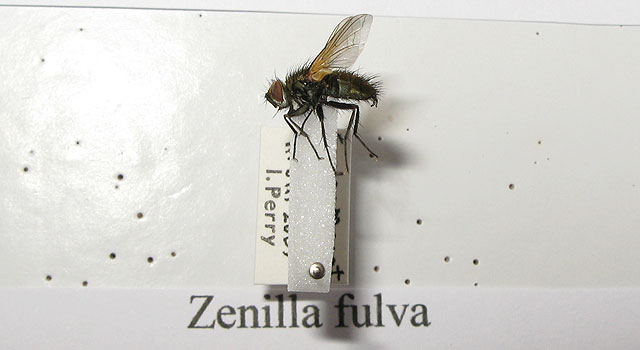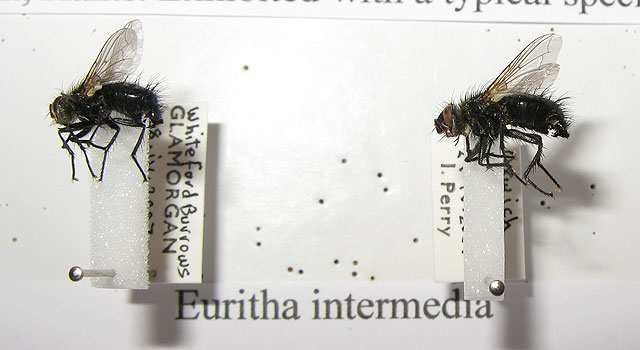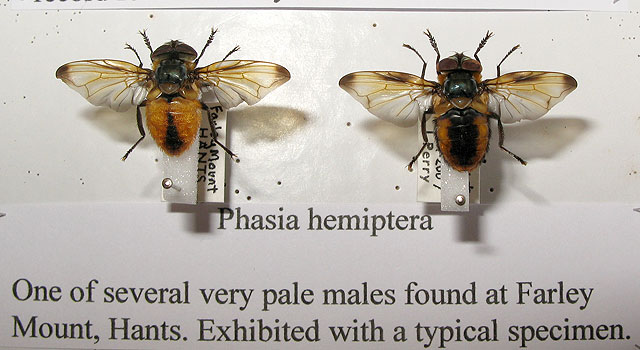Diptera.info :: Miscellaneous :: The Lounge
|
Tachinids from the BENHS exhibition
|
|
| ChrisR |
Posted on 12-11-2007 18:35
|
|
Super Administrator Location: Reading, England Posts: 7706 Joined: 12.07.04 |
Just wanted to show here some photos of some of Ivan Perry's exhibits at this year's British Entomological & Natural History Society (BENHS - http://www.benhs....) exhibition at Imperial College (London) on Saturday 10th November. Ivan is an amazing dipterist who seems to find rarities every year and has added 3 species to the British tachinid list in the last 2 years. This year he gave me 3 more specimens, which if confirmed, might add 2 more species to the list too! I'll start with Opesia grandis, an extremely rare species throughout Europe - found in 2006 and 2007 near Cambridge. ChrisR attached the following image:  [37.07Kb] Edited by ChrisR on 12-11-2007 18:45 |
| ChrisR |
Posted on 12-11-2007 18:37
|
|
Super Administrator Location: Reading, England Posts: 7706 Joined: 12.07.04 |
Next another rare species, Zenilla fulva, seen this year at Farley Mount, Hampshire - the first British record for about 40 years!
ChrisR attached the following image:  [29.53Kb] |
| ChrisR |
Posted on 12-11-2007 18:38
|
|
Super Administrator Location: Reading, England Posts: 7706 Joined: 12.07.04 |
Next Eurithia intermedia, found on flowers of creeping willow on dune systems in the Gower peninsular, Wales.
ChrisR attached the following image:  [41.1Kb] |
| ChrisR |
Posted on 12-11-2007 18:40
|
|
Super Administrator Location: Reading, England Posts: 7706 Joined: 12.07.04 |
Lastly, an interestingly pale/orange Phasia hemiptera (left) with a normal specimen (right), found at Farley Mount, Hampshire.
ChrisR attached the following image:  [55.89Kb] |
| Kahis |
Posted on 12-11-2007 18:52
|
|
Member Location: Helsinki, Finland Posts: 1999 Joined: 02.09.04 |
You wouldn't have a photo showing exactly how the first three flies are mounted. A micropin through the pleurae? But what keeps the rather large - in relation to a micropin - flies from rotating and shedding bristles and legs? Just very careful handling?  On any case, the end result looks very good indeed. Kahis |
| ChrisR |
Posted on 12-11-2007 19:41
|
|
Super Administrator Location: Reading, England Posts: 7706 Joined: 12.07.04 |
I actually use side-pinning for 95% of my specimens - just like Ivan does and I haven't had any problems with flies rotating on the micropin.  I think it really depends on a few things: the micro-pin shouldn't be too thin (I use 0.38-0.45mm diameter for most medium-large specimens) and the pin should be inserted at a slight angle - so that you don't destroy the same feature on both sides of the fly. The only difference is that I orient my specimens differently to Ivan, but the principle is the same. I think it really depends on a few things: the micro-pin shouldn't be too thin (I use 0.38-0.45mm diameter for most medium-large specimens) and the pin should be inserted at a slight angle - so that you don't destroy the same feature on both sides of the fly. The only difference is that I orient my specimens differently to Ivan, but the principle is the same.I prefer this method because everything is visible (in top-down pinning it's often more difficult to see the prosternum and legs) and the specimen is protected very well from vibrations etc.  They also take up a bit less space too They also take up a bit less space too 
Edited by ChrisR on 12-11-2007 19:45 |
| Tony Irwin |
Posted on 14-11-2007 00:23
|
|
Member Location: Norwich, England Posts: 7317 Joined: 19.11.04 |
Like Chris and Ivan, this is the system I use - if the fly is fresh, freshly thawed (from frozen) or freshly relaxed (from dry), then the muscles in the thorax will dry on the micropin and "glue" it in place. You can see that the stages are made of polythene foam; - this absorbs any vibration from handling the main pin, and grips the micropin firmly so that it doesn't rotate. I also micropin syrphids (from the top), up to the size of Eristalis and stage them on foam. They seem to suffer less damage than they used to when I did direct pinning. (I still use direct pinning for bigger syrphids and tabanids.) Tony ---------- Tony Irwin |
|
|
|
| Kahis |
Posted on 14-11-2007 14:32
|
|
Member Location: Helsinki, Finland Posts: 1999 Joined: 02.09.04 |
Chris Raper wrote: I think it really depends on a few things: the micro-pin shouldn't be too thin (I use 0.38-0.45mm diameter for most medium-large specimens) and the pin should be inserted at a slight angle - so that you don't destroy the same feature on both sides of the fly. Thanks for the description. But where did you find such large micropins? The largest I have seen for sale is 0.20 mm. Kahis |
| ChrisR |
Posted on 14-11-2007 19:12
|
|
Super Administrator Location: Reading, England Posts: 7706 Joined: 12.07.04 |
I use Watkins & Doncaster (www.watdon.com) D3 micro pins for most tachinids and A1 for the smaller stuff, like Siphona or Actia - though I have considered trying the Czech entosphinx pins. The main 'stage pin' is a 38mm continental pin at about >=0.5mm. The stage pins can be as thick as you like but the thicker the better so that they are easy to hold and don't flex when being pushed into cork etc.  |
| Zeegers |
Posted on 14-11-2007 20:47
|
|
Member Location: Soest, NL Posts: 19208 Joined: 21.07.04 |
Chris, Zenilllia fulva ?? Did I miss something ? Theo |
|
|
|
| ChrisR |
Posted on 14-11-2007 23:43
|
|
Super Administrator Location: Reading, England Posts: 7706 Joined: 12.07.04 |
Well spotted Theo ... a combination of a typo and there seems to be some confusion in the UK literature regarding the correct specific name. The current name should be Zenillia libatrix (Panzer, 1798) according to Belshaw & FaunaEuropaea but Chandler cites: ZENILLIA Robineau-Desvoidy, 1830 fulva (Fall?n, 1820 ? Tachina) =libatrix (Panzer, [1798] ? Musca), preocc. =macrops (Brauer & von Bergenstamm, 1891 ? Myxexorista) =ciligera: authors, misident. =fauna: authors, misident. which is probably where Ivan's and my confusion has occured. In my current draft of the new British tachinid handbook libatrix is used  |
| ChrisR |
Posted on 15-11-2007 10:59
|
|
Super Administrator Location: Reading, England Posts: 7706 Joined: 12.07.04 |
As a follow-up, for anyone with a copy of Chandler here is Peter Tschorsnig's explanation (pers.comm) of why libatrix is the correct name, over fulva: Well, this is the unlucky case of the old names described in the genus Musca (in the sense of the old authors, i. e. belonging to many diverse families and genera today). When Panzer in 1798 described his tachinid Musca libatrix, there was already a Musca libatrix existent, named by Scopoli in 1763, but this Musca libatrix of Scopoli is a Syrphidae (according to the Catalogue of Palaearctic Diptera its valid name is Sphaerophoria scripta Linnaeus, 1758). So Musca libatrix of Panzer is a primary homonym of Musca libatrix Scopoli, and when strictly applying to Art. 57.2 Panzer's junior name would be invalid. This was the reason why Chandler changed the name to fulva Fall?n, a mere formalism and not helpful in my opinion. It is clear, however, that Zenillia libatrix fulfills the condition of Art. 57.2.1 (which refers to Art. 23.9). So Zenillia libatrix remains valid because it is a nomen protectum (you may find the full text of the ICZN articles on http://www.iczn.o.../index.jsp). There was never a problem with the use of the two names. Nobody ever confounded libatrix Scopoli and libatrix Panzer because the species are of course quite different and systematically widely separated, and even the names could not have been confounded because libatrix Scopoli was not used as a valid syrphid name. Art. 23.9 was introduced to the Code to avoid such unnecessary changes of names. Chris R. Edited by ChrisR on 15-11-2007 11:03 |
| jorgemotalmeida |
Posted on 15-11-2007 14:16
|
|
Member Location: Viseu - PORTUGAL Posts: 9296 Joined: 05.06.06 |
I suppose that those flies are more common in Mediterranean regions? Is it rigth?  |
| ChrisR |
Posted on 15-11-2007 17:08
|
|
Super Administrator Location: Reading, England Posts: 7706 Joined: 12.07.04 |
Opesia grandis is incredibly rare *everywhere*  I received this from Peter Tschorsnig: I received this from Peter Tschorsnig: Opesia grandis is widespread in Europe (but - as far as known up to the present - obviously not in the typical hot Mediterranean or cold Northern countries). There are only scattered records everywhere so it must be regarded as a rare or very rare species (I never collected it by myself, Herting collected only a single specimen). Eurthia intermedia in Tschorsnig & Herting (1994): Europe to Scandinavia ... Dry, warm areas. End April to Mid June, 1 generation. On Euphorbia-flowers; rare. Host unknown. Zenillia libatrix in the same publication: Europe to Scandinavia; NS, NW, BW, BY, NB / A, CH. Bushes, forest edges. End April to Mid September (especially May), probably 2 generations. In open areas slightly commoner than the previous species [Zenillia dolosa], and also most often reared from the host. So, they're all quite rare and all but Opesia grandis might be commoner in the south  |
| jorgemotalmeida |
Posted on 15-11-2007 17:10
|
|
Member Location: Viseu - PORTUGAL Posts: 9296 Joined: 05.06.06 |
hmm.. interesting! I will try to seek for these flies. Any news, I will let know. |
| Zeegers |
Posted on 11-01-2008 15:36
|
|
Member Location: Soest, NL Posts: 19208 Joined: 21.07.04 |
Opesia grandis is more an easter thing. I got one in Siberia. Theo |
|
|
|
| Jump to Forum: |













